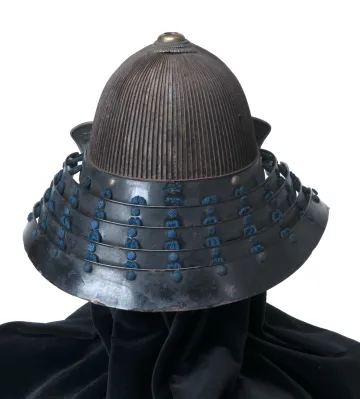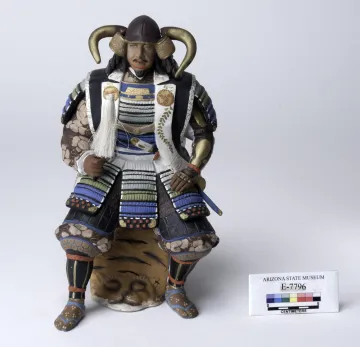
Japanese Helmet (Kabuto) and Half Mask (Mempo)
Edo Period (1603–1867), possibly earlier
Japan
Kabuto signed (Hisatada); Mempo – unknown maker
Steel, bronze, silk, with lacquer
Width: 11 in. (28 cm.), Height (top to chin): 12 in. (30.5 cm.)
Gift of John A. Logan, 1949
(ASM Catalog Nos. E–2400, E–2402e)
The kabuto has laced, lacquered scales, or kozane, to protect the nape of the neck. The accompanying armor was also constructed of kozane, which were originally made of leather and later replaced by steel. The laced design coupled with thin high-grade steel made the armor light and allowed samurai to be agile, unlike their European counterparts.
This kabuto is made of 120 individual riveted steel plates, rather than the standard 62 or fewer. This construction, when combined with the signature of the artisan, Hisatada, on the interior, tells us that this is an extremely fine example worn by an important samurai.
Note that the fukigaeshi, or “blow-back,” on either side of the visor display the bronze family crest, or kamon, of the wild goose (karigane). Riveted to the visor is the crest-holder (oharaaidate,) which would have held a larger version of the kamon. Together these would identify the samurai on the battlefield.
I chose this kabuto and mempo because I think it is pretty cool that this type of armor was the inspiration for Darth Vader’s helmet in the epic film saga Star Wars. George Lucas, director of Star Wars, was a big fan of the Japanese filmmaker Akira Kurosawa, who depicted feudal Japan in inimitable style in his most famous film, The Seven Samurai (1954). Lucas told his concept illustrator Ralph McQuarrie that he wanted Darth Vader to look like “a dark lord riding on the wind,” with black flowing robes, a large helmet like that of the Japanese samurai, and a mask covering his face.







